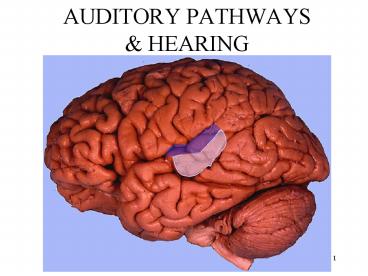AUDITORY PATHWAYS - PowerPoint PPT Presentation
1 / 31
Title: AUDITORY PATHWAYS
1
AUDITORY PATHWAYS HEARING
2
(No Transcript)
3
Auditory Projections
4
Tonotopic Organization of A1
5
Medial Geniculate Nucleus
Auditory Cortex
Inferior Colliculus
Cochlear Nucleus
Left Auditory Nerve
Superior Olive
Right Auditory Nerve
6
Auditory Pathways
Medial Geniculate Nucleus
Auditory Cortex
Inferior Colliculus
Cochlear Nucleus
Superior Olive
Left Auditory Nerve
Right Auditory Nerve
7
Auditory Pathways
- Auditory Nerve - Axons from hair cells
- Cochlear Nucleus - Sends information from the
auditory nerve to the Superior Olive and to the
Inferior Colliculus - Superior Olive - Analogous to the Optic Chiasm -
information from both ears crosses over to be
sent to both hemispheres - Inferior Colliculus - Analogous to the Superior
Colliculus for vision - Orienting and reflexive
localization -- recent studies show multimodal
neurons in the colliculus which share visual and
auditory information for orientation movements - Medial Geniculate Nucleus (MGN) Relays
information from the SO to A1
8
Range of Hearing
20 50 100 200 500
1000 2000 5000 10000 Frequency (Hz)
9
Range of Hearing
Range of speech sounds
20 50 100 200 500
1000 2000 5000 10000 Frequency (Hz)
10
Audiogram
11
Audiogram
critical for certain consonants
12
Hearing Loss
- Conduction Deafness - any damage to the middle
ear which impairs hearing - Nerve Deafness or Presbicusis- Effects High
Frequencies - Less elasticity in the Basilar
membrane - Loss of nutrients to cochlea -
Cumulative effects of noise - Noise Exposure - Effects High Frequencies - Both
Sudden and prolonged exposure - When high Frequency hearing is impaired speech
perception becomes increasingly difficult
13
Auditory Impairments, Sensory Substitution
Treatments
14
Types of Impairment
- Conduction Deafness
- Nerve Deafness
- Cortical Deafness
15
Conduction Deafness
- Anything up to but not including the cochlea
- Obstructions
- Damage
16
Treating Conduction Deafness
- Remove Obstruction
- Repair Eardrum
- Repair Ossicles
- Open Eustacian Tube
17
Nerve Deafness
- Damage to the Cochlea, Or Path to Cortex
- Cilia or Hair Cells
- Basilar Membrane
- Auditory Nerve
- Olive
- Auditory Tract
- Inferior Colliculus
- MGN of Thalamus
- Auditory Projections
18
Causes of Type I Nerve Deafness
- Presbycusis Old Ear -- High Frequency hearing
loss - Noise Induced Hearing Loss Also effects high
frequencies Damage to cilia or Bassilar
membrane -- Tinitus - Infection of Cochlea Damage to cilia
- Meniers Disease Excessive fluid pressure in
Cochlea damages Organ of Corti.
19
(No Transcript)
20
Treating Type I Nerve Deafness
- Cochlear Implant
21
Cochlear Implant Internal
22
Cochlear Implant
- Recall that the cochlea is coiledAnd that the
basillar membrane selects frequencies - The electrode has multiple stimulation points
that selectively activate nerves at the
appropriate places
23
(No Transcript)
24
(No Transcript)
25
(No Transcript)
26
(No Transcript)
27
Nerve Deafness
- Damage to the Cochlea, Or Path to Cortex
- Cilia or Hair Cells
- Basilar Membrane
- Auditory Nerve
- Olive
- Auditory Tract
- Inferior Colliculus
- MGN of Thalamus
- Auditory Projections
28
Causes of Type II Nerve Deafness
- Degenerative nerve disease
- Congenital disorder
- Infection
- Stroke
- Trauma
29
Treating Type II Nerve Deafness
- No cure at present
- Stem cells research is designed to allow new
nerve growth in damaged areas. - Has already worked with Parkinsons and
Tourrettes - Should work for vision, audition, Alzheimers,
Epilepsy, stroke, etc.
30
Summary of Nerve Deafness
- Caused by damage between cochlea and cortex
- Cochlear Implants
- Stem Cell Research
31
Sensory Substitution
- ASL
- Closed Captioning Foundation































